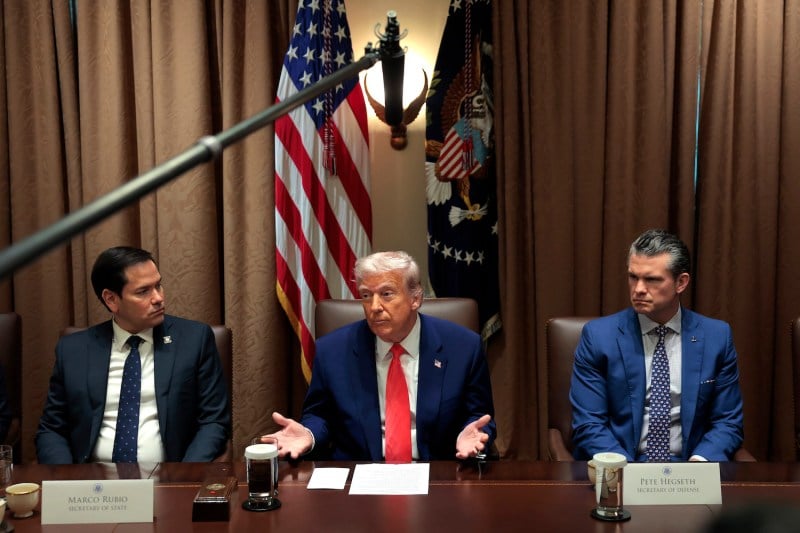Trump’s Defense Plans Are a Reagan Redux

Trump’s Defense Plans Are a Reagan Redux
Both men granted the Pentagon blank checks to spend on their outlandish national-security obsessions.
U.S. President Donald Trump delivers remarks alongside Secretary of State Marco Rubio and Secretary of Defense Pete Hegseth during a cabinet meeting at the White House in Washington on April 10. Anna Moneymaker/Getty Images
The Department of Government Efficiency (DOGE) continued to steamroll the administrative state in recent weeks as Social Security became the latest target of billionaire Elon Musk’s rampage. Around the country, field offices of the Social Security Administration have lost as much as 57 percent of their staff, according to a New York Times investigation. The 72 million Americans who rely on Social Security checks now face longer processing times and a website that keeps crashing.
As DOGE widens its reach, even the military seems to be vulnerable to cuts. In March, the Defense Department claimed to be “working hand-in-glove with DOGE” to “trim the fat.” The announcement followed a proposal from February to cut some $250 billion from the Pentagon’s budget over the next five years. But on April 7, Trump and Defense Secretary Pete Hegseth pledged that the next defense budget would be a record-setting $1 trillion. “[W]e’re very cost-conscious, but the military is something we have to build,” Trump said at a press event that day.
The Department of Government Efficiency (DOGE) continued to steamroll the administrative state in recent weeks as Social Security became the latest target of billionaire Elon Musk’s rampage. Around the country, field offices of the Social Security Administration have lost as much as 57 percent of their staff, according to a New York Times investigation. The 72 million Americans who rely on Social Security checks now face longer processing times and a website that keeps crashing.
As DOGE widens its reach, even the military seems to be vulnerable to cuts. In March, the Defense Department claimed to be “working hand-in-glove with DOGE” to “trim the fat.” The announcement followed a proposal from February to cut some $250 billion from the Pentagon’s budget over the next five years. But on April 7, Trump and Defense Secretary Pete Hegseth pledged that the next defense budget would be a record-setting $1 trillion. “[W]e’re very cost-conscious, but the military is something we have to build,” Trump said at a press event that day.
As Trump’s latest comments reveal, neither DOGE nor the Pentagon intend to reduce military spending. Instead, Trump plans to shift Pentagon resources in ways both predictable and far-fetched. Aside from cutting the few million dollars that the Defense Department has earmarked for diversity, equity, and inclusion programs as well as the billions committed to protecting against climate change, the White House promises to unleash the Pentagon like never before.
One of Trump’s priorities is the U.S.-Mexico border, where he has already deployed thousands of infantry, National Guard members, and armored vehicles. Even costlier will be the “Golden Dome,” the president’s proposal—by executive order—for a U.S. “missile defense shield” modeled on Israel’s Iron Dome. If completed, the project would fulfill President Ronald Reagan’s failed Strategic Defense Initiative of the 1980s, better known as “Star Wars.” Early cost estimates range from the hundreds of billions of dollars to as much as $2.5 trillion.
History reveals Trump’s Golden Dome for the grift that it is. National security experts doubt that the program is any more achievable than it was in Reagan’s day—and they question the idea that a continent-sized shield would give taxpayers good bang for their buck.
But Star Wars’ failures were not just technical. The folly of Trump’s Reagan redux is not only in reopening a 40-year-old money pit, but also in continuing the myth that Americans’ security can be measured by the size of Pentagon programs or the fantasies of the commander in chief.
Comparisons between Trump and Reagan are not new. As the White House lays waste to entire arms of the government, historians and commentators have looked back to “the Gipper,” whose cuts to social spending, attacks on public employees and unions, and declaration that “government is the problem” paved the way for DOGE’s gambit.
Anti-Trump conservatives, meanwhile, reject the comparison by contrasting Trump’s isolationism and abuse of U.S. allies with Reagan’s statesmanship and ability to compromise.
But another important precedent for today’s policies has largely escaped attention. The Trump administration is also taking a page from Reagan’s military playbook by spending freely on the president’s bugbears and national security obsessions.
Like Trump, Reagan took office amid fears of a criminal “invasion” at the southern border. His 1980s buildup in border security also blurred the lines between immigration enforcement, national defense, and the “war on drugs.” And while the damage of DOGE is in many ways unprecedented, it’s not the first time that an aerospace executive—in this case, Musk—has leveraged wealth and corporate power to influence federal spending.
Despite his reputation as an enemy of big government, Reagan neither balanced the budget nor starved the federal bureaucracy, as he promised from the outset of his administration. Instead, the president and Congress budgeted hundreds of billions of dollars for new missiles, futuristic military technologies, and tax cuts to corporations and the wealthy. Today’s Republicans are determined to do the same.
“No American president before Reagan had invested so much rhetorical value in the cause of a balanced budget,” the sociologist Melinda Cooper observed in her 2024 book, Counterrevolution: Extravagance and Austerity in Public Finance. “And no other president had done so much to ensure it wouldn’t happen.” When it comes to the Pentagon, Trump is clearly following in these footsteps.
Consider Reagan’s nearly $2 trillion military buildup. From the moment he took office in 1981, Reagan looked to confront a Soviet Union whose influence was growing “at our doorstep” amid revolutions in Nicaragua and Grenada and a civil war in El Salvador. Within his first 100 days, Reagan launched the largest missile and defense buildup in peacetime history. The announcement of the Star Wars initiative came two years later. Once again, Reagan invoked the threat posed by leftist governments in the Caribbean and Central America.
Yet Reagan’s eagerness to reheat the Cold War was also an economic strategy. The new administration inherited an economy already weakened by a decade of inflation and deindustrialization. Americans’ outlook only grew more pessimistic in Reagan’s first year once the country entered a steep recession. By late 1982, unemployment reached double digits.
In this context, “Reagan and his fellow Republicans saw the defense economy as an antidote to domestic economic pressures in a postindustrial age,” the historian Michael Brenes observed in his 2020 book For Might and Right: Cold War Defense Spending and the Remaking of American Democracy. By 1985, the defense industry had added more than 600,000 jobs thanks to Star Wars and the arms race. Republican-leaning districts in the so-called gun belt—a region that spans from San Diego County to the suburbs of Washington, D.C., and is home to a significant number military-adjacent industries—experienced historically low unemployment rates.
Meanwhile, workers in steel, auto, and rubber manufacturing—the backbone of the labor movement and the Democratic Party since the New Deal—suffered a new round of deindustrialization. Employees of General Motors and Firestone feared recession and foreign competition, but demand for missiles and microchips never faltered. This was Reagan’s “hidden” and partisan version of industrial policy, as the economist Robert Reich explained at the time. (Reich would later serve as secretary of labor under President Bill Clinton.)
More than anyone, defense contractors reaped the benefits of this missile and space buildup. The industry had ties to Reagan dating back years. As the governor of California in the 1970s, Reagan opposed arms control policies and the winddown of the Vietnam War on the industry’s behalf. When the Los Angeles-based Lockheed nearly went bankrupt in 1970, Reagan successfully lobbied Congress to underwrite a $250 million loan to the company.
Reagan’s support for the industry reached new heights in the 1980s, in the era of Star Wars. Military contractors, including Donald Rumsfeld, filled key positions in the White House. Longtime Reagan ally and Bechtel vice president Caspar Weinberger served as the secretary of defense for more than six years, until the Iran-Contra scandal forced his resignation in November 1987. Although Weinberger was later indicted on charges of lying to Congress, Reagan awarded his friend “Cap” the Presidential Medal of Freedom for his loyal service and dedication to the Strategic Defense Initiative. (President George H.W. Bush pardoned Weinberger in 1992, before he could face trial.)
Democratic critics, including Rep. John Conyers, marveled at how little the program accomplished despite its eye-watering cost. The science behind Star Wars had been speculative at best, as Conyers pointed out. Researchers at the country’s top universities spent the 1980s exploring whether it was possible to stop a long-range Soviet missile using projectiles, lasers, thousands of satellites, or even a nuclear detonation in space.
Nothing came close to delivering the impenetrable “shield” Reagan envisioned. While chairing a congressional hearing on the program, Conyers dubbed Star Wars “a reverse Rumpelstiltskin” that had “spun gold into straw.”
While the Pentagon and its contractors reaped big in the 1980s, nondefense programs came under attack. Like Trump and DOGE today, Reagan slashed federal payrolls and programs, including Social Security. He rolled back the rights of workers and unions. And he ushered in the present age of inequality with policies that redistributed wealth and income upward.
But Reagan’s policies also undermined economic growth. An economy geared toward war was always vulnerable to sudden changes in federal funding and shifting geopolitics. By the mid-1980s, Democrats as well as Republicans increasingly questioned the wisdom of Star Wars and the arms race amid underfunded social programs and $2 trillion in federal debt. When the Cold War ended, Congress seized the opportunity to slash the Pentagon budget—resulting in mass layoffs and base closures that triggered a recession.
Like Reagan before him, Trump’s second term promises a major windfall for the defense and aerospace industry—starting with Musk. On April 4, Musk’s SpaceX signed a multibillion-dollar contract to execute rocket launches for the U.S. Space Force. Musk’s ultimate dream is to secure federal funding for a manned mission to Mars—a feat that Trump has called “our manifest destiny.”
Musk and SpaceX also stand to profit from Trump’s “Golden Dome” gambit. National security experts have described the project as “futuristic,” “a fantasy,” and “hugely expensive, unrealistic and counterproductive.” Even if it proves possible to build, the Golden Dome is guaranteed to siphon military resources and drive up costs—as happened during the 1980s.
“A defensive dome for the United States—a country hundreds of times the size of Israel—would require massive scale, as well as space-based interceptors, and almost certainly be decades away,” CNN reported. The outlet noted that a modest prototype of a shield that Lockheed Martin is developing in Guam has already faced serious roadblocks.
“There is zero possibility of a comprehensive missile defense of the United States in the foreseeable future,” concluded James N. Miller, a former undersecretary for defense in the Obama administration, in an interview with the Washington Post.
The Golden Dome—Star Wars 2.0—can only repeat the failures of its forerunner. While Star Wars promised to make a Soviet nuclear attack impossible, Reagan’s vision for weapons in space functioned “as a boon to the military-industrial complex, more than it contributed to American national security interests,” Brenes, the historian, wrote. It’s no surprise that the Golden Dome’s biggest boosters outside Trump’s inner circle are defense and space contractors.
Meanwhile, in the halls of Congress, Democrats have repudiated Trump’s attempts to lay claim to Reagan’s muscular foreign policy.
“President Trump loves to say ‘peace through strength,’” Senator Elissa Slotkin of Michigan said in her party’s rebuttal to the president’s recent address to Congress. “Reagan must be rolling in his grave.”
Yet Democrats should do better than trying to claim Reagan for themselves. In key respects, his legacy is also the blueprint for Trump’s second term: a blank check for the Pentagon and tax cuts for the rich, a war on unions and workers, and a mission to dismantle government agencies that enable millions of people to live safer and more decent lives.
Beating back the onslaught of Trump and DOGE—not co-opting the Republican message—will be the true test of Democrats’ strength in the weeks and months ahead.
This post is part of FP’s ongoing coverage of the Trump administration. Follow along here.
David Helps is a postdoctoral scholar in the Van Hunnick History Department and the Society of Fellows in the Humanities at the University of Southern California. His writing on police, cities, and international affairs has appeared in the Washington Post, the Los Angeles Review of Books, and Monthly Review, among other outlets. X: @davidrhelps
More from Foreign Policy
-

An illustration shows a line of large shopping carts facing down a small Donald Trump figure holding two shopping bags. The stars of China’s flag are in the upper left corner. Why Beijing Thinks It Can Beat Trump
China’s elites have a new confidence in their own system.
-

U.S. Army Chief of Staff Randy George speaks to U.S. soldiers at the Hohenfels Training Area in southern Germany on Feb. 6. A Drawdown of U.S. Forces in Europe Is All but Certain
Here’s how the Pentagon can rebalance its approach to the continent without sacrificing U.S. interests.
-

University of California, Los Angeles students, researchers, and demonstrators rally during a “Kill the Cuts” protest against the Trump administration’s funding cuts on research, health, and higher education in Los Angeles on April 8. Why Authoritarians Attack Universities First
A Yale professor and expert on fascism talks about why he’s leaving the United States under Trump.
-

Dwight D. Eisenhower looks over a piece of paper while sitting on a couch as Robert Cutler looks over his shoulder. How Generations of Experts Built U.S. Power
And now Trump is throwing it all away.







Join the Conversation
Commenting on this and other recent articles is just one benefit of a Foreign Policy subscription.
Already a subscriber?
.
Subscribe
Subscribe
View Comments
Join the Conversation
Join the conversation on this and other recent Foreign Policy articles when you subscribe now.
Subscribe
Subscribe
Not your account?
View Comments
Join the Conversation
Please follow our comment guidelines, stay on topic, and be civil, courteous, and respectful of others’ beliefs.
Change your username |
Log out
Change your username:
CANCEL
Confirm your username to get started.
The default username below has been generated using the first name and last initial on your FP subscriber account. Usernames may be updated at any time and must not contain inappropriate or offensive language.